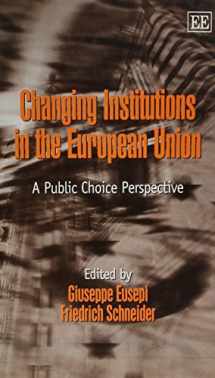
Changing Institutions in the European Union: A Public Choice Perspective
ISBN-13:
9781843765158
ISBN-10:
1843765152
Edition:
0
Author:
Friedrich Schneider, Giuseppe Eusepi
Publication date:
2004
Publisher:
Edward Elgar Publishing
Format:
Hardcover
240 pages
FREE US shipping
Book details
ISBN-13:
9781843765158
ISBN-10:
1843765152
Edition:
0
Author:
Friedrich Schneider, Giuseppe Eusepi
Publication date:
2004
Publisher:
Edward Elgar Publishing
Format:
Hardcover
240 pages
Summary
Changing Institutions in the European Union: A Public Choice Perspective (ISBN-13: 9781843765158 and ISBN-10: 1843765152), written by authors
Friedrich Schneider, Giuseppe Eusepi, was published by Edward Elgar Publishing in 2004.
With an overall rating of 4.1 stars, it's a notable title among other
books. You can easily purchase or rent Changing Institutions in the European Union: A Public Choice Perspective (Hardcover) from BooksRun,
along with many other new and used
books
and textbooks.
And, if you're looking to sell your copy, our current buyback offer is $0.4.
Description
This book makes a valuable, analytical contribution to recent debates on the ongoing institutional changes occurring within the European Union. It provides a comprehensive and diverse insight into a variety of areas, including in-depth studies of fiscal, monetary and voting issues, to help elucidate the current period of transitional change. The authors argue that a fiscal constitution is essential to help solve the deficits and debts that member countries face due to welfare state financing. Moreover, they believe that the successful implementation of a fiscal constitution is the key to a more coherent institutional setting for Europe as a whole. Although monetary institutions within the EU have already secured a degree of constitutional solution in the form of the euro, they warn that its stabilising power should not be overestimated: the European Central Bank has yet to experience financial crises like those faced by the Federal Reserve Bank. The authors move on to propose a new parliamentary design for Europe and assess the advantages for the elite of a small country to join the EU, compared to the population at large. This volume comprehensively explores the rapidly changing institutional configuration of the EU, employing both qualitative and quantitative approaches. It will be required reading for scholars of public choice, and those with an interest in political economy and EU integration. It is also an excellent sourcebook on European institutions and would provide useful complementary reading in a variety of undergraduate and postgraduate courses.


We would LOVE it if you could help us and other readers by reviewing the book
Book review

Congratulations! We have received your book review.
{user}
{createdAt}
by {truncated_author}


